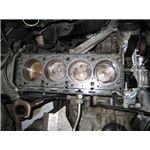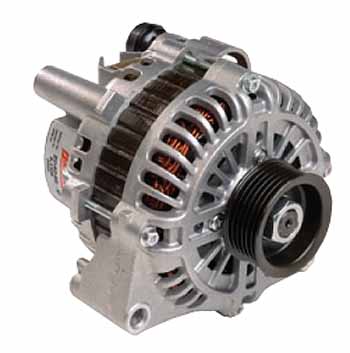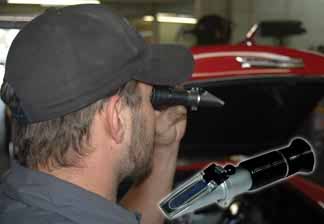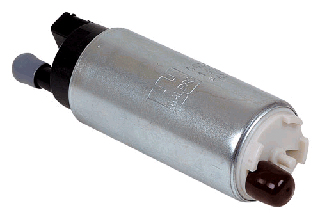 Determining whether or not your vehicle has a blown head gasket, cracked head, or some other serious engine problem can sometimes be a difficult task. A compression test can tell you that cylinders are low but don’t always indicate what the problem is and can lead to wasted money. This article will discuss a method on how to test for a cracked head or blown head gasket. This method is extremely simple and can be accomplished in several minutes with the right tools. To understand how this method works we will have to discuss how your engine’s cooling system works. Your engine’s cooling system works by flowing coolant through a radiator and allowing air to pass through thus cooling the coolant. The coolant then travels through a hose to the engine block. The engine block has many coolant passages that flow through it. These passages flow through the block itself and through the heads. If you have a blown head gasket or cracked head, you will end up having several situations occur. The first is that you can end up burning coolant in your engine. This is not good and can lead to premature bearing failure. When engine oil and coolant mix the coolant displaces the oil and your engine lacks lubrication because in place of oil there is coolant. Another thing that can occur when you burn coolant is that you can cause a severe overheat condition for your engine. This can lead to piston’s reaching excessive temperatures and expanding and touching the cylinder walls. This will cause scoring of the cylinders and pistons. The last common problem that can occur is that combustion gases escape into your cooling system. This can cause a decrease in power, and if in excess can cause cooling system problems. With all of these problems at risk and now that you understand how your engine’s cooling system works, we can now discuss the simple procedure to determine whether or not your engine in deed has a cracked head or blown head gasket.
Determining whether or not your vehicle has a blown head gasket, cracked head, or some other serious engine problem can sometimes be a difficult task. A compression test can tell you that cylinders are low but don’t always indicate what the problem is and can lead to wasted money. This article will discuss a method on how to test for a cracked head or blown head gasket. This method is extremely simple and can be accomplished in several minutes with the right tools. To understand how this method works we will have to discuss how your engine’s cooling system works. Your engine’s cooling system works by flowing coolant through a radiator and allowing air to pass through thus cooling the coolant. The coolant then travels through a hose to the engine block. The engine block has many coolant passages that flow through it. These passages flow through the block itself and through the heads. If you have a blown head gasket or cracked head, you will end up having several situations occur. The first is that you can end up burning coolant in your engine. This is not good and can lead to premature bearing failure. When engine oil and coolant mix the coolant displaces the oil and your engine lacks lubrication because in place of oil there is coolant. Another thing that can occur when you burn coolant is that you can cause a severe overheat condition for your engine. This can lead to piston’s reaching excessive temperatures and expanding and touching the cylinder walls. This will cause scoring of the cylinders and pistons. The last common problem that can occur is that combustion gases escape into your cooling system. This can cause a decrease in power, and if in excess can cause cooling system problems. With all of these problems at risk and now that you understand how your engine’s cooling system works, we can now discuss the simple procedure to determine whether or not your engine in deed has a cracked head or blown head gasket.
How do I know if my Head Gasket is blown? Using a pressure tester to determine if you have a blown head gasket
October 3rd, 2011Rear Brakes W/H Integral Parking Brake
April 14th, 2011Installing rear brake pads on a vehicle equipped with an integral parking brake may be difficult if you don’t know what you are doing.
For those who do not know an integral parking brake means that your caliper piston does two jobs. First it applies pressure to the pads when you press the brake pedal. Second it has a ratchet mechanism to apply pressure when you press the parking brake. How this system works is the caliper piston instead of just pushing out like it would on a normal system, rotates while it comes out. The rotation is how the parking brake applies. This is what makes changing brake pads difficult on these vehicles if you don’t have the correct tool. You need a tool that rotates and presses the piston in at the same time.
How do I replace my GM V6 Intake Gaskets?
March 27th, 2011Intake gaskets can be a very costly failure if you do not service them immediately upon finding them worn. The intake gaskets on GM 3.1 liter, 3.4 liter, and 3.8 liter are very well known for having troubles. These are some vehicles that have intake gasket problems. So if you have a vehicle with one of these engines in them, make sure that you ask your dealership about some of the updated gaskets and intake manifolds to help prevent the failure.
We will discuss how an intake gasket fails. Generally the intake gasket fails so that you will have engine coolant leaking into the engine. This is bad because a liquid is not only uncompressible and can hydro lock a motor but it does not mix with oil. If you run the engine long enough with this leak then you will have a lack of lubrication because there will be water in your oil and water does not have the lubrication properties of engine oil.
Understanding the PCV System How to Replace PCV valve?
March 1st, 2011The PCV system on modern vehicles plays a major role in the proper operation of the engine. It is a very simple system and often time is forgotten about in diagnosis. The PCV or Positive Crankcase Ventilation system if working incorrectly can lead to many problems in driveability.
The PCV system works by allowing fresh air from your intake tubing to blow through the engine. This clean air then mixes with hydrocarbons and then passes into your intake manifold to be burned. The PCV system prevents pressure from building up in your engine and is also an emission device.
If you have a PCV system that is not working correctly you can have many problems with your vehicle. We will discuss some of these problems but first we must understand the components of the PCV system.
How to Clean a Throttle Body on a Car
February 8th, 2011Cleaning your throttle body.
A dirty throttle body can cause many different vehicle related concerns. It can cause a lack in power, hard starting, poor idling, stalling, and many more problems. Overtime your throttle body will begin to gain carbon and after time will cause some driveability concerns.
The carbon on the throttle body causes a lack of air or restrictions to airflow. This will affect your vehicle’s performance. It is normal and should not require a whole lot of skill to fix. This article will discuss the procedure to fix your dirty throttle body.
Replacing Valve Guide Seals
January 30th, 2011Changing valve guide seals in the vehicle.
A common problem among vehicles especially older vehicles is leaking valve guide seals. They are a cheap item but the labor rate a shop can charge may make it very expensive. The task of changing your valve guide seals is actually fairly straight forward and can be accomplished in a weekend with a couple special tools.
A valve seal is a simple seal. There are several different kinds of valve seals depending on the time in which your vehicle was manufactured. The most effective kind of valve seal is the positive style seal, this fits over the valve guide itself and is stationary. The next seal is the umbrella style seal, this seal rides with the valve stem and prevents oil from going down the guide. The last style of valve seal is the o-ring. This was extremely common on older style engines and was the least effective of any of the seals. You don’t have to worry if you have o-ring style seals they were still effective at sealing the guide, it is just over time they become brittle due to heating and cooling.
How to Replace an Automotive Alternator
November 13th, 2010 Replacing your alternator
Replacing your alternator
If your battery on your vehicle is constantly going dead forcing you to have to jump start your vehicle, it is likely that you have an alternator that is not working correctly.
The alternator on your vehicle provides voltage to your vehicle. This voltage is created and used by your vehicle and the accessories in your vehicle. The alternator produces more voltage than your vehicle needs and the excess voltage is then stored in your vehicles battery. The battery will provide a supply of voltage to start the vehicle. If your alternator is not putting out as much voltage as it should be then it will not have any excess to charge your battery, thus causing you to have a dead battery when you go to start your vehicle.
I suggest that you review this Basic Electronics article before you go ahead and replace your alternator. A simple test that you can do is to test the voltage at your battery with your vehicle running. You should have something greater than 13.5 DC Volts, this shows that your alternator is providing enough voltage to charge the battery.
Once you have determined that you need to replace your alternator then you can move onto the next procedure that we will discuss.
How do I accurately test my Coolant?
September 12th, 2010 Any time is a good time to test your coolant but most important is when winter months are approaching. I know that there are many other articles on how to check your engines coolant for the proper mixture. I am not saying that any of these methods are incorrect.
Any time is a good time to test your coolant but most important is when winter months are approaching. I know that there are many other articles on how to check your engines coolant for the proper mixture. I am not saying that any of these methods are incorrect.
I am going to discuss a method in this article, which I find to be the most accurate method possible. The problem with some of the other methods such as the floating ball method is that there are many different kinds of coolants out there. This means that you have to have the exact tester for those coolants to make the gauge read accurately. Sometimes you may also be unsure what type of coolant is in the vehicle, and you then don’t know what tester to use. This can also lead to using an incorrect tester and getting incorrect reading that either say your coolant is the correct mixture when it is not, or else saying it needs more antifreeze when it does not.
The method this article is going to focus on is using a refractometer. A refractometer, such as this ATD3705 Coolant Refractometer or Robinair 75240 I have found to be the most versatile, accurate and economical way of checking cooling systems.
How to replace my fuel pump? Replacing your fuel pump safely!
August 6th, 2010 When it comes to getting fuel to your engine it is the fuel pumps job to maintain a constant flow of fuel from your tank through the fuel lines into the engine. A common problem with fuel pumps is that they wear out over time and simply fail. Replacing a worn out fuel pump is not that difficult of a task, but it can be extremely dangerous. If you think about it you have a tank full of fuel and lines containing pressurized fuel. This is why it is important that you follow these steps to help you accomplish the task of replacing your fuel pump safely. Read the rest of this entry »
When it comes to getting fuel to your engine it is the fuel pumps job to maintain a constant flow of fuel from your tank through the fuel lines into the engine. A common problem with fuel pumps is that they wear out over time and simply fail. Replacing a worn out fuel pump is not that difficult of a task, but it can be extremely dangerous. If you think about it you have a tank full of fuel and lines containing pressurized fuel. This is why it is important that you follow these steps to help you accomplish the task of replacing your fuel pump safely. Read the rest of this entry »
How should I service my car battery?
July 25th, 2010 Battery Service When it comes to your vehicle the battery is one of the most important items. It not only starts your vehicle but without it the vehicle will not run. Overtime batteries release chemicals and the terminals corrode and can cause a poor connection resulting in a vehicle that will not start or resembles a vehicle with a poor battery. It is simple to clean the posts on a battery. I will describe how to properly clean the posts and maintain your battery to insure that it has the longest life possible. Read the rest of this entry »
Battery Service When it comes to your vehicle the battery is one of the most important items. It not only starts your vehicle but without it the vehicle will not run. Overtime batteries release chemicals and the terminals corrode and can cause a poor connection resulting in a vehicle that will not start or resembles a vehicle with a poor battery. It is simple to clean the posts on a battery. I will describe how to properly clean the posts and maintain your battery to insure that it has the longest life possible. Read the rest of this entry »
